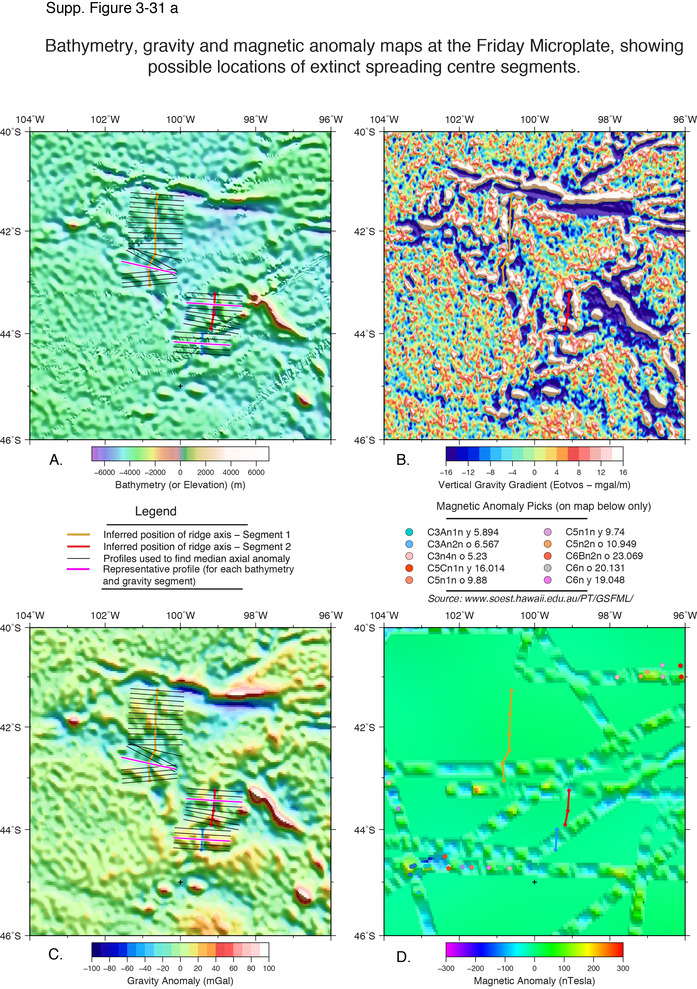| Ocean: | Pacific |
| Spreading center type: | Extinct microplate spreading ridge |
| Time of cessation: | 12 Ma, Chron 5A (Tebbens et al., 1997) |
| Subsequent active spreading center: | Chile Ridge (southern extension of the EPR) |
| Cessation style: | Likely to have been gradual, during propagation of new ridge. |
| Later deformation or volcanism: | None is evident or previously reported. |
Complex reorganizations of the Pacific-Antarctic-Nazca plate boundary during the Cenozoic are argued to have led to formation of a short-lived microplate referred to as the Friday Microplate, within the south East Pacific. Oceanic crust formed at the currently active Chile Ridge spreading system is bounded by the Friday Trough on the west and the Crusoe Trough on the east (Tebbens et al., 1997). At latitude 38° S, to the west of this tract of seafloor there is a region of rough seafloor that suggests a complex rearrangement of plate boundaries, argued to have been formed at the Friday microplate during the Micoene. This crust is of older age, as demonstrated by a decrease in average depth across the Friday Trough to the west.
Tebbens et al. (1997) argue that the Friday Microplate was formed in a similar fashion as the active Juan Fernandez microplate that spreads from two bounding ridges on either side of the plate and that no axial ridge is preserved by the migration due to the new spreading centers remaining active to the present day (Antarctic-Pacific and Nazca-Pacific respectively). This hypothesis suggests that the microplate was disrupted by ridge propagation by a northward oriented propagator at C5Ao that subdivided the plate, with the Nazca-side crust preserving a fanning structure within magnetic anomalies that reflect higher spreading rates in the south (Tebbens et al., 1997). It is argued that magnetic anomalies from the west of the Friday Trough (anomaly C5D) are continuous with those to the east of the Crusoe Trough (C5E).
The Selkirk Trough is not implicated within the plate boundary reoganisation discussed by Tebbens et al., 1997 and by exclusion is taken to represent a “crack” in the oceanic lithosphere, rather than a pseudofault or spreading center. The age of lithosphere in which this structure is situated smoothly ages to the east according to the magnetic anomaly identifications of Tebbens et al., 1997.
Tebbens et al. (1997) propose a tectonic scenario for capture of the Friday plate formed crust, by disruption of a northward propagator that rotated the microplate, and accreted the plate to the Antarctic plate. In their model, the triple-point intersection of Pacific-Antarctic-Nazca plates migrates from the Valdivia FZ to the more northerly Challenger FZ, thereby accreting the Friday Microplate to the Antarctic plate, which then allowed both the PAC-ANT and Chile Ridge to continue spreading.
The schematic illustrations of Tebbens et al. (1997) appear to show that plate accretion is occuring at the edges of the Friday Microplate and that there are three discrete pieces of ocean crust that are accreted to the Pacific plate on the western side of the EPR. They do not indicate where the Friday Trough extinct spreading center is located. South of 41 S there is a prominent linear gravity low evident in the VGG maps of Sandwell et al. (2014). We consider this as a possible extinct spreading center from the central portion of the Friday Microplate. Profiles across the structures show significant variation in the along-axis structure that make it difficult to confirm that this is the former spreading center. However, each of the defined segments have bathymetric relief and peak-to-trough axial gravity signal that is within a standard deviation of the mean of the well-defined extinct ridges.
Bird, R. T., Naar, D. F., Larson, R. L., Searle, R. C. and Scotese, C. R., 1998, Plate tectonic reconstructions of the Juan Fernandez microplate: transformations from internal shear to rigid rotation, Journal of Geophysical Research, v. 103, no. B4, p. 7049-7067.
Tebbens, S. F., Cande, S. C., Kovacs, L., Parra, J. C., LaBrecque, J.L. and Vergara, H., 1997, The Chile ridge: a tectonic framework, Journal of Geophysical Research, v. 102, no. B6, p. 12,035-12,059.
Tebbens, S. F., and Cande, S. C., 1997, Southeast Pacific tectonic evolution from early Oligocene to present, Journal of Geophysical Research, v. 102, no. B6, p. 12,061-12,084.


